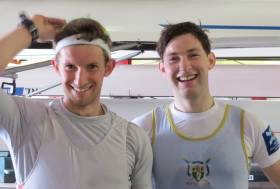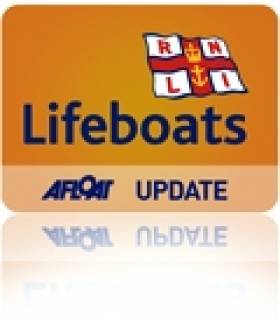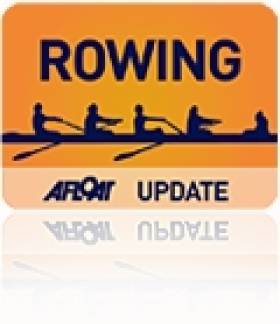Displaying items by tag: Lee
Commercial and UCD Double Test O'Donovans at Cork Regatta
#Rowing: Niall Beggan and Andrew Goff gave Gary and Paul O’Donovan a good battle in the Division One double sculls at Cork Regatta today. The Ireland under-23 lightweights, drawn from UCD and Commercial, placed second behind the Ireland senior lightweight double, ahead of Shane O’Driscoll and Mark O’Donovan.
NUIG won the men’s fours and the Skibbereen/UCC composite the women’s four by convincing margins. Cork won the women’s double, while Lee’s juniors took second.
Cork Regatta, National Rowing Centre, Cork, Day Two (Selected Results)
Men
Four – Div One – A Final: 1 NUIG (sen) 6:16.41. Four, coxed – Div Two – A Final: 1 Queen’s B (club two) 6:53.69, 2 St Michael’s (jun 18B) 6:56.53; 6 Presentation, Cork (jun 16) 7:33.61.
Sculling, Double – A Final: 1 Skibbereen (G O’Donovan, P O’Donovan; sen) 6:25.51, 2 Commercial, UCD (N Beggan, A Goff; sen) 6:27.62, 3 Skibbereen (M O’Donovan, S O’Driscoll; sen) 6:37.997; 5 Three Castles A (jun 18A) 6:49.76. B Final: St Michael’s (inter) 6:51.20.
Single – Div Two – A Final: 1 Three Castles (A Keogh; jun 16) 7:29.64, 2 Cappoquin (S Landers; club two) 7:35.39; 6 Killorglin (J McCarthy; Jun 18B) 7:52.86.
Women
Four – Div One – A Final: 1 Skibbereen, UCC (N Casey, E Hegarty, A Keogh, D Walsh; sen) 6:59.0. B Final: Col Iognaid (jun 18A) 7:39.68.
Sculling, Double – Div One – A Final: 1 Cork (inter) 7:19.591, 2 Lee (jun 18A) 7:23.45. B Final: 2 Carlow (club one) 7:40.31.
Skibbereen and UCD Race in World-Class Quadruple at NRC
#Rowing: The men’s quadruple gave four top internationals the chance to show their speed at Skibbereen Regatta. Shane O’Driscoll, Paul O’Donovan, Gary O’Donovan and Mark O’Donovan won in a very good time of six minutes 29.9 seconds. NUIG’s two women’s coxed fours were also impressive – the B crew won well from the A crew in the Division One A Final. Two junior 16 competitors from Castleconnell, Norma Silke and Lauren O’Brien, zoomed away from the rest to win the Division Two double sculls, while Lee’s senior crew took the honours in the women’s quadruple. Enniskillen’s junior 18 crew won the Division One coxed four.
Skibbereen Grand League Regatta, National Rowing Centre, Day One (Selected Results; with Per Centage of Projected World Best Time)
Men
Eight – Division Two – A Final: 1 Queen’s (nov) 7:04.6. 3 Univ of Limerick (club two) 7:25.3, 6 Col Iognaid (jun 16) 7:40.6.
Four, coxed – Div One – A Final: 1 Enniskillen (jun 18A) 7:09.5 (82.18), 2 UCD (inter) 7:11.7 (81.78), 3 NUIG (sen) 7:12.9 (81.54). B Final: 2 NUIG (club one) 7:29.8 (78.48).
Pair – A Final: 1 Skibbereen (sen) 7:43.6 (80.46), 2 Commercial (sen) 7:50.8, 3 Enniskillen (jun 18A) 7:56.4; 4 Cork A (inter) 8:04.8 (76.95). C Final: 3 St Michael’s (club one) 8:10.1 (76.11).
Sculling,
Quadruple – Division One – A Final: 1 Skibbereen/UCD (sen) 6:29.9 (85.41), 2 Commercial (sen) 6:49.0 (81.42), 3 Shandon (jun 18A) 6:52.2 (80.79), 4 St Michael’s (club one) 7:11.0 (77.26).
Double – Div Two – A Final: 1 Castleconnell (jun 16) 8:51.7, 2 Shandon (club two) 9:17.3 (71.24). B Final: 2 Athlunkard (jun 18B) 9:57.4.
Single – A Final: 1 UCD (P O’Donovan; senior) 7:58.3 (81.78 per cent), 2 Skibbereen (G O’Donovan; sen) 8:03.4 (80.88), 3 UCD (A Goff; lightweight) 8:17.1 (78.66). B Final: 2 Skibbereen (K Mannix; intermediate) 8:21.6 (77.95); 5 Three Castles (R Quinn; jun 18A) 8:36.4 (75.71).
Women
Eight – Div Two – A Final: 1 Shandon (club two) 7:47.5; 4 NUIG (nov) 8:09.8. 5 Col Iognaid (jun 16) 8:12.8. Four, coxed – Division One – A Final: 1 NUIG B (inter) 8:03.5 (80.87), NUIG A (inter) 8:12.6 (79.37), 3 Cork (sen) 8:18.4 (78.45); 6 UCC (club one) 8:40.7 (75.9).
Pair – A Final: 1 UCC (sen) 8:39.8 (79.06), 2 Cork (inter) 8:40.5 (78.96), 3 Fermoy (jun 18A) 8:47.1 (77.97). B Final: 3 Belfast BC (club one) 9:14.9 (74.07); 6 Cork A (jun 18A) 9:35.7 (71.39)
Sculling
Quadruple – Div One – A Final: 1 Lee (sen) 7:35.2 (80.18), 2 Fermoy, Carlow, Skibbereen, Kenmare 7:36.6 (79.94), 3 Workmans (jun 18A) 7:48.1 (77.98).
Div Two, coxed – A Final: Cork (jun 18B) 8:34.6, 2 Lee A (club two) 8:47.4, 3 Carlow (jun 16), 4 Garda (club two) 9:00.0. B Final: 2 UCD A (nov) 9:21.4.
Double – Div Two – A Final: 1 Castleconnell (jun 16) 8:51.7, 2 Shandon (club two) 9:17.3. B Final: 2 Athlunkard (jun 18B) 9:57.4.
Single – A Final: 1 Old Collegians (S Puspure; sen) 8:33.5 (82.97), 2 Killorglin (M Dukarska; sen) 8:45.0 (81.14), 3 UCD (A Crowley; inter) 9:06.8 (77.91). B Final: 3 Col Iognaid (C Nic Dhonncha; jun 18A) 9:38.1 (73.69), 4 Lee Valley (E O’Mahony; club one) 9:45.6 (72.75).
Lee's Cremen and Synott Take Division One Honours
#Rowing: Lee’s junior women won the Division One double sculls at the Skibbereen Regatta at the National Rowing Centre. Margaret Cremen and Claire Synott had already taken the Division One quadruple, in combination with Eimear Cummins and Maedbh Heaney. Queen’s won the men’s double and the men’s four, where they were involved in a two-boat race with UCC. The women’s four gave UCD the opportunity for an emphatic victory.
Skibbereen Regatta, National Rowing Centre, Cork, Saturday (selected results)
Men
Eight – Division Two – A Final: 1 Trinity A (novice) 6:18.4; 2 UCC (club two) 6:22.0; 4 Cork (jun 18B) 6:30.7. B Final: Shandon (jun 16) 6:33.9.
Four – Division One – A Final: 1 Queen’s (sen) 6:37.6, 2 UCC (sen) 6:44.1. Division One (coxed) – A Final: 1 NUIG (sen) 6:52.4, 2 Queen’s (club one) 6:56.1, 3 Trinity (club one) 6:56.9; 5 St Joseph’s A (jun 18A) 7:02.2. B Final: 1 UCC (inter) 6:58.4. Div Two (coxed) – A Final: 1 Cork BC (jun 18B) 7:12.8; 2 Commercial B (club two) 7:14.1. B Final: Presentation, Cork (jun 16) 7:37.1.
Pair – Division One – A Final: 1 Trinity (sen) 6:56.8, 2 Commercial A (sen) 7:00.0, 3 Commercial C (sen) 7:01.2; 5 UCC (inter) 7:11.3. B Final: 1 Trinity A (sen) 7:12.4; 4 Queen’s (club one) 7:27.1.
Sculling, Quadruple – Division One – A Final: 1 Shandon/Athlone (sen) 6:15.0, 2 Shandon (jun 18A) 6:16.1, 3 Commercial (jun 18A) 6:22.7. B Final: 1 Skibbereen (inter) 6:39.5; 2 Queen’s (club one) 6:46.1.
Double – Div One – A Final: 1 Queen’s (sen) 6:44.1, 2 Shandon/Clonmel (sen) 6:50.3, 3 Castleconnell (inter) 6:53.4. B Final: 1 Belfast BC (inter) 7:05.7. Div Two – A Final: 1 Carlow (jun 18B) 7:04.6; 2 Skibbereen (club two) 7:11.9. B Final: 2 Waterford (jun 16) 7:26.1.
Single – Div One – A Final: 1 Queen’s (P Doyle, sen) 7:18.2, 2 Clonmel (D Lynch; jun 18A) 7:18.5, 3 Queen’s (C Beck; lwt) 7:24.3; 4 Skibbereen (F McCarthy; inter) 7:26.4. B Final: 1 Garda (D Kelly; sen) 7:32.8; 5 UCC (D Synott; club one) 7:46.2. Div Two – A Final: 1 Carlow (O’Brien; club two) 7:41.8; 2 Lee Valley (C Cummins; jun 18B) 7:43.8; 5 Carlow (J Keating; jun 16) 7:58.0.
Women
Eight – Div Two – A Final: 1 UCD (club two) 7:02.8; 3 Shandon (jun 18B); 5 Col Iognaid (jun 16). B Final: 4 Trinity A (nov) 7:44.2. Four – Division One – A Final: 1 UCD (sen) 7:20.9, 2 Skibbereen (jun 18A) 7:34.9, 3 Trinity B (sen) 7:35.3.
Division One (coxed) – A Final: Commercial (inter) 7:36.9, 2 UCD (sen) 7:37.5, 3 St Michael’s (inter) 7:46.8; 4 Queen’s (club one) 7:55.8. B Final: 1 NUIG (club one) 7:44.3.
Pair – Div One – A Final: 1 Cork (jun 18A) 7:55.47, 2 UCC (inter) 8:08.1, 3 Queen’s (inter) 8:14.8; 4 Trinity (club one) 8:21.6.
Sculling,
Quadruple – Division One – A Final: 1 Lee (jun 18A) 7:20.4, 2 Skibbereen (jun 18A) 7:25.1, 3 Fermoy (club one) 7:27.3; 4 UCC (inter) 7:30.2, 5 Belfast BC, Queen’s, Fermoy (sen) 7:30.9. B Final: Commercial (jun 18A) 7:47.6. Div Two – A Final: 1 Cork A (jun 18B) 7:46.4; 2 Workman’s (jun 16) 7:49.0; 6 St Michael’s (club two) 8:15.6. C Final: 5 Univ of Limerick (nov) 8:56.2.
Double – Division One – A Final: 1 Lee (jun 18A): 7:42.4, 2 Neptune (jun1 18A) 7:50.3, 3 Trinity (inter) 7:54.4; 4 Skibbereen (sen) 8:10.5. B Final: 1 NUIG A (club one) 8:11.5.
Div Two – A Final: 1 Carlow (club two) 8:02.4; 2 Carlow (jun 18B) 8:08.6; 3 Workman’s (jun 16) 8:11.0.
Single – Div One – A Final: 1 Killorglin (M Dukarska; sen) 7:55.4, 2 Skibbereen (D Walsh; sen) 7:58.9, 3 Skibbereen (S Dolan; sen) 8:05.8; 4 Skibbereen (E Hegarty; jun 18A) 8:12.6, 5 UCD (A Crowley; inter) 8:20.4. B Final: 1 Skibbereen (O Hayes; lightweight) 8:27.7; 4 Belfast BC (O Blundell; club one) 8:32.8. C Final: 1 Garda (B Larsen; inter) 8:36.81.
Shandon First and Second in Quadruples Final
#Rowing: Shandon impressed in the second set of finals at the Skibbereen Regatta at the National Rowing Centre. Their senior composite quadruple, with Athlone’s Patrick Munnelly, won the Division One A Final, holding off a Shandon junior quad. Lee won the women’s Division One quad. NUIG were well on top in the men’s coxed four, but the women’s race was a battle to the line, with Commercial just holding off UCD.
Skibbereen Regatta, National Rowing Centre, Cork, Saturday (selected results)
Men
Eight – Division Two – A Final: 1 Trinity A (novice) 6:18.4; 2 UCC (club two) 6:22.0; 4 Cork (jun 18B) 6:30.7. B Final: Shandon (jun 16) 6:33.9.
Four – Division One (coxed) – A Final: 1 NUIG (sen) 6:52.4, 2 Queen’s (club one) 6:56.1, 3 Trinity (club one) 6:56.9; 5 St Joseph’s A (jun 18A) 7:02.2. B Final: 1 UCC (inter) 6:58.4.
Pair – Division One – A Final: 1 Trinity (sen) 6:56.8, 2 Commercial A (sen) 7:00.0, 3 Commercial C (sen) 7:01.2; 5 UCC (inter) 7:11.3. B Final: 1 Trinity A (sen) 7:12.4; 4 Queen’s (club one) 7:27.1.
Sculling,
Quadruple – Division One – A Final: 1 Shandon/Athlone (sen)
6:15.0, 2 Shandon (jun 18A) 6:16.1, 3 Commercial (jun 18A) 6:22.7. B Final: 1 Skibbereen (inter) 6:39.5; 2 Queen’s (club one) 6:46.1.
Double – Div Two – A Final: 1 Carlow (jun 18B) 7:04.6; 2 Skibbereen (club two) 7:11.9. B Final: 2 Waterford (jun 16) 7:26.1.
Single – Div One – A Final: 1 Queen’s (P Doyle, sen) 7:18.2, 2 Clonmel (D Lynch; jun 18A) 7:18.5, 3 Queen’s (C Beck; lwt) 7:24.3; 4 Skibbereen (F McCarthy; inter) 7:26.4. B Final: 1 Garda (D Kelly; sen) 7:32.8; 5 UCC (D Synott; club one) 7:46.2. C Final: Portadown (S McKeown; sen) 7:25.0
Women
Eight – Div Two – A Final: 1 UCD (club two) 7:02.8; 3 Shandon (jun 18B); 5 Col Iognaid (jun 16). B Final: 4 Trinity A (nov) 7:44.2. Four – Division One (coxed) – A Final: Commercial (inter) 7:36.9, 2 UCD (sen) 7:37.5, 3 St Michael’s (inter) 7:46.8; 4 Queen’s (club one) 7:55.8. B Final: 1 NUIG (club one) 7:44.3.
Pair – Div One – A Final: 1 Cork (jun 18A) 7:55.47, 2 UCC (inter) 8:08.1, 3 Queen’s (inter) 8:14.8; 4 Trinity (club one) 8:21.6.
Sculling,
Quadruple – Division One – A Final: 1 Lee (jun 18A) 7:20.4, 2 Skibbereen (jun 18A) 7:25.1, 3 Fermoy (club one) 7:27.3; 4 UCC (inter) 7:30.2, 5 Belfast BC, Queen’s, Fermoy (sen) 7:30.9. B Final: Commercial (jun 18A) 7:47.6. Div Two – A Final: 1 Cork A (jun 18B) 7:46.4; 2 Workman’s (jun 16) 7:49.0; 6 St Michael’s (club two) 8:15.6. C Final: 5 Univ of Limerick (nov) 8:56.2.
Double – Div Two – A Final: 1 Carlow (club two) 8:02.4; 2 Carlow (jun 18B) 8:08.6; 3 Workman’s (jun 16) 8:11.0.
Single – Div One – A Final: 1 Killorglin (M Dukarska; sen) 7:55.4, 2 Skibbereen (D Walsh; sen) 7:58.9, 3 Skibbereen (S Dolan; sen) 8:05.8; 4 Skibbereen (E Hegarty; jun 18A) 8:12.6, 5 UCD (A Crowley; inter) 8:20.4. B Final: 1 Skibbereen (O Hayes; lightweight) 8:27.7; 4 Belfast BC (O Blundell; club one) 8:32.8. C Final: 1 Garda (B Larsen; inter) 8:36.81.
Fisher Entertains By the Lee in Aid of the RNLI (Photos here!)
#SAILING BY THE LEE – Maritime journalist Bob Fisher entertained over 200 guests today at the annual RNLI "Sailing by the Lee" Lunch 2012 in Cork. SCROLL DOWN FOR PHOTOS BELOW BY BOB BATEMAN.
The large crowd from the maritime community in Cork gathered at the Maryborough Hotel and Spa in Cork for the ninth annual Sailing by the Lee lunch. Kindly supported by Port of Cork and Electric Bar/Restaurant, the event was a huge success with well known faces from the maritime world and Cork's social scene gathering to raise funds for Kinsale and Crosshaven RNLI stations in their work saving lives at sea. €11,650 was raised to go directly towards operations at both stations.
The highlight of the lunch was special guest, international marine journalist Bob Fisher, who had flown in from the UK for the event. Following; an introduction via Skype from Canada by International Marine Architect Ron Holland, Bob recalled his experiences over some 70 years as a world renowned journalist, capturing history unfolding in the worlds of ocean & inshore racing, cruising and the friendships inevitably made.
During the lunch, RNLI Patron Donal McClement paid a special tribute to Bob on his remarkable career, "I wish to acknowledge Bob's absolute dedication; commitment and enthusiasm in representing those connected to the sea, in bringing the thrills and excitement of events such as the Admiral's and America's Cup back to us at home and capturing the ongoing challenges and adventures of the international maritime community."
Bob Fisher is best known for capturing the America's Cup throughout the years and has published extensively on this and other leading events.
Familiar well known faces who attended on the day included Donal McClement, Peter & Marie Crowley, Conor & Mauritta Doyle, Anthony & Sally O' Leary, Vinny O' Shea, Naval Captain Bob Scarret, Port of Cork's Capt McCarthy, Alan Barton, John P O' Gorman and Tom McSweeney.
Speaking after the event, RNLI Governor Peter Crowley stated:-
"Our sponsors and supporters for this year's event have been extremely generous and we are very grateful to them, particularly given the challenging economic climate. In particular, I would like to thank Port of Cork and Electric Bar & Restaurant, South Mall. We are delighted to have Bob Fisher and his wife, Dee with us this year-with their help, we raised sufficient funds today to replace and update all crew lifejackets at both the Kinsale and Crosshaven Stations."
Cork Crews Rise to the Top at Cork Head
Cork crews saw off rivals from far and near at the Cork rowing Head of the River at the Marina on Saturday. UCC’s men’s senior eight were the fastest men’s crew – by 1.3 seconds from De Maas of Rotterdam, a masters eight. The fastest women’s crew was Cork Boat Club’s junior 18 eight, adjudged just .8 of a second quicker than UCD’s women’s senior eight. The fastest men’s single sculler was John Keohane of Lee Valley and Karen Corcoran-O’Hare of Shandon was the fastest women’s single sculler.
Cork Head of the River, The Marina, Cork, Saturday
Overall: 1 UCC men’s senior eight 12 minutes 6.7 seconds, 2 De Maas, Rotterdam men’s masters eight 12:08.0, 3 UCC men’s novice eight 12:25.9, 4 UCD men’s novice eight 12:42.4, 5 Presentation College men’s junior eight 12:44.3, 6 Muckross intermediate eight 12:49.9.
Men, Eight – Senior: UCC 12:06.7. Intermediate: Muckross 12:49.9. Novice: UCC 12:25.9. Junior: Presentation 12:44.3. Junior 16: Cork 13:21.2. Masters: De Maas 12:08.0.
Fours – Senior: Cork/Garda 12:53.6. Intermediate: UCC 13:40.6. Novice: Cappoquin 13:43.9. Junior 18, coxed: Presentation 13:04.0
Pair – Junior 18: Presentation 14:58.7. Masters: De Maas 13:09.9. Coastal – Novice: Ahakista 17:28.7.
Sculling, Quadruple – Senior: Shannon 13:50.8. Novice: Shannon 15:07.4. Junior 18: Cork 13:05.3. Junior 16: Cork 13:15.2.
Double – Intermediate: Cork IT 13:41.6. Junior 18: Clonmel 13:53.9. Junior 16: St Michael’s 15:04.4. Coastal – Novice: Kilmacsimon 16:17.2.
Single – Senior: Lee Valley (J Keohane) 14:16.4. Intermediate: Lee (O’Connell) 14:53.4. Novice: Lee (O’Connell) 14:37.9. Junior 18: Workmen’s (Burns) 14:33.0. Junior 16: Shandon (Casey) 15:08.9. Masters: Skibbereen (Barry) 15:40.07. Coastal – Novice: Kilmacsimon 17:33.6
Women – Overall: 1 Cork junior eight 13:40.0, 2 UCD senior eight 13:40.8, 3 St Michael’s junior eight 13:54.1.
Eight – Senior: UCD 13:40.8. Novice: UCC 14:25.4. Junior 18: 1 Cork 13:40.0. Junior 16: Clonmel 16:21.0.
Four – Senior: Muckross 14:15.9. Intermediate: UCC 17:00.9. Novice: UCC 16:29.8. Masters: Skibbereen 22:34.9.
Pair – Junior 18: St Michael’s 15:00.2.
Sculling, Quadruple - Novice: Shannon 15:51.4. Junior 16: St Michael’s 15:16.5.
Double – Intermediate: UCC 16:15.1. Junior 18: Cork 14:43.9. Junior 16: Lee 15:42.3. Masters: Cork 15:38.3.
Single – Senior: Intermediate: Shandon (K Corcoran-O’Hare) 15:39.7. Junior 18: Lee (Kearney) 16:52.1. Junior 16: Lee (Hamel) 16:13.6. Masters: Cork (Crowley) 17:49.2.
Coastal: 1 Kilmacsimon men’s novice double scull 16:17.2, 2 Ahakista men’s novice quadruple coxed scull 17:28.7.
Click this link for Irish Rowing detailsClick this link for the Latest Rowing News
































































